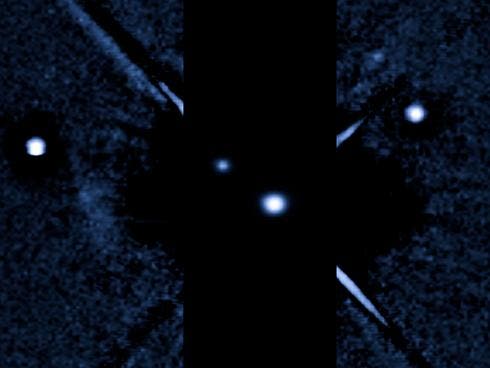
Astronomers have discovered a fourth moon orbiting Pluto via the famous Hubble telescope, NASA announced this Wednesday.
Some of you might be wondering, just exactly how was it possible for astronomers to have missed it so far, considering NASA’s been tracking space rocks even from the edge of the solar system. The truth is, our solar system is vast, and more or less everything revolves around a game of chance. In case of pluto’s newly discovered forth moon, temporarily dubbed P4 until a more mythologically-suited title can be attained, the object is so small that it simply didn’t stood out yet.
Actually, NASA says there’s a chance it appeared as a very faint smudge in 2006 images, but was overlooked because it was obscured by the short exposure time.
Discovered during a Hubble survey that was looking for rings around the dwarf planet, P4 has an estimated diameter between eight to 21 miles and is located between the orbits of Nix and Hydra, Pluto’s second and, respectively, third-largest moons, which were discovered by Hubble in 2005. Charon is the largest, with a diameter of more than 1,000 kilometers.
“I find it remarkable that Hubble’s cameras enabled us to see such a tiny object so clearly from a distance of more than three billion miles,” says Mark Showalter of the SETI Institute, who led the observations.

The discovery comes right in the nick of time, as NASA scientists prep for the much anticipated New Horizons mission, scheduled to fly through the Pluto system in 2015.
“This is a fantastic discovery,” said New Horizons’ principal investigator Alan Stern of the Southwest Research Institute in Boulder, Colo. in the statement. “Now that we know there’s another moon in the Pluto system, we can plan close-up observations of it during our flyby.”
NASA scientists believe Pluto’s moons formed after another large object collided with it in the early years of our solar systems. As a result of the clash, material was sprung out and thus Pluto’s four moons, that we know of, were formed. Looking for rings around Pluto that might have been coalesced around the same period with the moon formations, Hubble caught a glimpse of P4 absolutely by chance with its Wide Field Camera 3 on June 28, and confirmed the sighting in pictures taken on July 3 and July 18.
Pluto has been caught up in a continuing astronomical debate over the definition of a planet since a 2006 International Astronomical Union vote to make it a dwarf planet.






